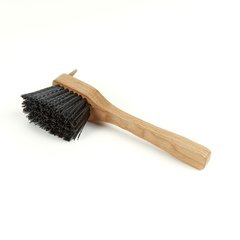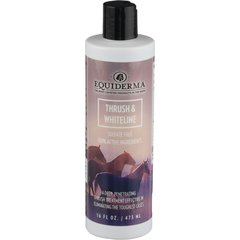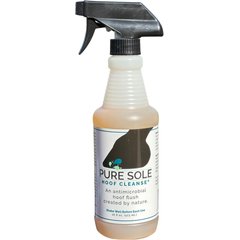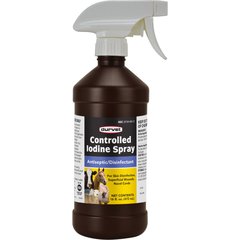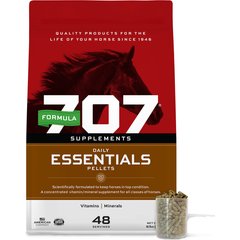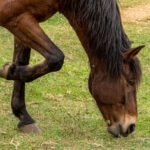The Best Treatments for Thrush in Horses: Prevention, Care, and Recovery

Photo by MelissaAnneGalleries/iStock/Getty Images Plus
If you’ve ever cared for a horse with thrush, you can probably smell it as you read this; the foul odor of a thrushy hoof is unforgettable. Even worse, thrush infections can cause lameness in horses if left untreated.
Thrush develops rapidly in moist conditions. That’s why most equestrians keep a bottle of their favorite thrush remedy on hand at all times. To banish thrush from your barn for good, though, you’ll need to focus on environment and hygiene, not just topical treatment.
To learn more about thrush prevention, care, and treatment, we spoke with Natalie Lord, DVM, a large- and small-animal veterinarian at Four Paws – Cuatro Patas in Austin, Texas, and Karin Floyd Jones, a Tucson, Arizona-based barefoot trimmer at TLC Hoof Trimming.
Key Takeaways
- Thrush in horses is a bacterial infection caused by naturally occurring microorganisms.
- Environmental hygiene, daily hoof cleaning, regular hoof trimming, and exercise help to prevent thrush.
- The most common signs of thrush in a horse’s foot are black discharge and a strong sulfur smell.
- Many different topical thrush treatments may be effective, but caustic products should be avoided unless prescribed by your equine veterinarian.
- Thrush may return if the horse’s hooves are not kept clean after recovery.
What Is Thrush in Horses?
Definition and Causes
Thrush in horses is a common bacterial infection of the hooves. It’s most often found in the sulci of the hoof’s frog—those are the grooves on each side of the frog and down its middle.
Studies have shown that thrush can be caused by multiple species of bacteria, with one of the most common being Fusobacterium necrophorum.
Bacteria are everywhere, but healthy hooves in clean, dry environments rarely develop thrush. Most infections are due to an underlying cause in the environment, the hoof, or the body. According to our hoof care experts, common causes of thrush include:
- Infrequent hoof cleaning
Recommended Product
- Standing in a wet environment, especially if manure is present
- Stall bedding that doesn’t absorb much moisture, such as straw
- Hooves that aren’t trimmed often enough, or are trimmed improperly
- Lack of exercise
- Medical conditions affecting the immune system or reducing blood flow to the hooves
Symptoms
Most cases of thrush in horses are obvious to the naked eye—not to mention the naked nose. Thrush symptoms may include:
- A strong sulfur smell (like rotten eggs) coming from the hoof when it’s lifted or cleaned
- Crumbly black paste on or around the frog, especially in the grooves on each side of the frog or the central sulcus of the hoof
- Progressive deepening of the central and collateral sulci
- Peeling outer frog tissue, with deep divots in the layer underneath
- Central sulcus cracks running from the rear of the frog up between the heel bulbs of the hoof and extending beyond the hairline at the coronet band
- In severe cases, softening and crumbling of the sole or the space between the wall and sole
- Tenderness to hoof testers (pincers used to apply pressure to areas of the hoof to check for pain), paired with any of the above symptoms
- Lameness, paired with any of the above symptoms
Diagnosing Thrush
A correct diagnosis is essential before applying thrush treatment. Many thrush symptoms overlap with other conditions, such as white line disease and hoof abscesses.
Barefoot trimmer Jones says: “I tell my clients that if you can see black when picking your horse’s hooves, you have thrush. You may also see odd little holes or divots in the frog, and a deep line between the heel bulbs that you can stick a hoof pick in.”
If you’re still unsure, your trusted farrier, barefoot trimmer, or equine veterinarian can tell you whether or not your horse has thrush. A thorough, professional thrush exam may require trimming away excess tissue from the sole and frog to expose infected layers.
Because thrush is generally caused by anaerobic bacteria, which can survive without the presence of oxygen, this process also gives you a jump start on treatment by exposing the infected tissue to oxygen. The most common thrush-causing bacterium, Fusobacterium necrophorum, dies when exposed to the air. So the more you clean your horse’s feet, the faster your horse recovers.
Equine Thrush Remedies
Cleaning the Hoof
Your first line of defense against thrush is your trusty hoof pick.
Recommended Product
Dig every bit of debris out of the hoof at least once a day, paying special attention to the stinky, thrushy collateral grooves and the central sulcus. A hoof pick with a stiff brush on one side, like this one from Shires, helps to get the soles and frog extra clean.
Recommended Product
Keep up this daily hoof-picking routine year-round and you’ll rarely deal with thrush.
Topical Treatments
Every horse owner has a favorite thrush remedy. Because several different microorganisms may cause this infection, thrush treatments may work differently for different horses.
Jones and Dr. Lord shared a few of their go-tos with us:
- Jones always reaches for an antimicrobial clay-based thrush treatment first. Clays won’t damage healthy tissue, and don’t need to be reapplied as often as other treatments.
Recommended Product
- Products containing zinc oxide, like Equiderma, are effective against a wide range of thrush-causing bacteria.
Recommended Product
- Powdered clay with zinc sulfite offers another way to get thrush-fighting zinc into your horse’s hooves, without the mess of liquid or clay products.
Recommended Product
- For mild cases of thrush, try a natural spray containing apple cider vinegar and honey.
Recommended Product
- Dr. Lord emphasizes that hoof cleaning is the most important part of thrush treatment, but topical products like Kopertox can help, too.
Recommended Product
- Any disinfectant effective against anaerobic bacteria, such as chlorhexidine and iodine, may be used to fight thrush.
Recommended Products
Whichever product you choose, get it deep into all the nooks and crannies of each infected hoof. Reapply according to the manufacturer’s instructions until the infection is completely resolved.
Professional Care
No treatment can cure your horse’s thrush permanently if underlying hoof problems remain. That’s where your hoof care professional and your veterinarian come in.
Jones says that “a properly cared-for hoof is the best prevention. Contracted heels are a risk factor for thrush, as are overgrown frogs with flaps that trap bacteria.”
Your veterinarian has a role to play, too, especially with stubborn, recurring thrush. For difficult cases, Dr. Lord often prescribes an antibiotic called cephapirin (developed for mastitis in cows), which can be syringed into the collateral grooves and central sulcus of an infected hoof. Always talk to your vet before giving antibiotics, whether topically or orally.
If nothing seems to help, your veterinarian may recommend further testing for nutritional deficiencies and underlying metabolic conditions, such as Cushing’s disease.
A hay analysis or pasture analysis can tell you if your horse is eating a diet that lacks trace minerals like copper and zinc, which support healthy hooves.
Environmental Management
Thrush-causing bacteria love two things: moisture and manure. Recurring thrush, or thrush in multiple horses, indicates a need to change your management practices. Try these steps:
- Provide more turnout and exercise, ideally in dry conditions with varied footing.
- Keep stalls, paddocks, and pastures dry and clean, to the best of your ability. Don’t let horses stand in soggy shavings or boggy mud.
- Bacteria thrive in what scientists call “fecal slurry” (mud made out of manure). So remove manure promptly, especially when rain is in the forecast.
- If your horses churn up their paddocks and dry lots, try a rotation system or a track system to provide enrichment while preventing mud buildup.
Equine Thrush Prevention Strategies
The best defense against thrush is simply good care. Implement these key practices to prevent thrush, whether or not your horse has already had an infection:
- Clean hooves daily and check for signs of thrush.
- Go no more than six to eight weeks between visits from your farrier or barefoot trimmer, even if your horse’s hooves don’t appear to be overgrown.
- Feed a balanced diet.
- Ask your veterinarian if ration balancing supplements, such as ProElite Grass Advantage, or trace minerals, such as Formula 707 Daily Essentials, are recommended based on the type of forage your horse eats.
Recommended Products
- Consider a daily biotin supplement to improve hoof growth and quality.
Recommended Product
- Remove manure promptly.
- Keep stall bedding clean and dry.
When To Seek Veterinary Help
After a week or two of daily hoof cleaning, environmental hygiene, and topical treatment, you should see improvement. If your horse’s thrush is no better or seems to be getting worse, it’s time to see your veterinarian.
Other signs that your horse needs professional care include:
- Lameness, which points to either a severe infection or another problem in addition to thrush
- Visible inflammation and abnormal overgrowth of the frog, which may be a different and more serious condition called canker
- Blood or pus coming from the hoof
- A strong digital pulse, which could point to an abscess or laminitis
- Low appetite or an overall dull appearance
If you think your horse isn’t healing normally, your equine veterinarian will always be happy to take a look. As they say, “no hoof, no horse.”
Most horses will deal with thrush at some point in their lives. We can’t control every possible cause of thrush. Paddocks get muddy when it rains. Human emergencies get in the way of daily hoof cleaning. When our horses get thrush despite our best efforts, help is available from a wide variety of thrush treatments and natural remedies.
Still, we can keep thrush to a minimum, and save our horses a lot of discomfort, by committing to proper hoof hygiene, regular professional care, and environmental cleanliness. A few extra minutes spent on good hoof care today may save you hours of frustrating thrush treatment in the future.
FAQs About Thrush in Horses
Can you ride a horse if they have thrush?
If the horse is sound, go right ahead. Exercise is beneficial for thrush prevention and treatment. However, you should not ride a lame horse unless your veterinarian has specifically instructed you to do so as part of a rehabilitation plan.
Can apple cider vinegar cure thrush in horses?
When applied to clean hooves and allowed to dry, apple cider vinegar may help treat mild thrush infections.
What happens if thrush in horses is left untreated?
Untreated thrush can lead to lameness, deterioration of the hooves, and increased susceptibility to other more serious hoof diseases.
What is the best quickest thrush treatment for horses?
It depends on the severity of the infection and its underlying cause. Many horses with thrush see quick improvement after a properly balanced trim from their farrier or barefoot trimmer, followed by packing the hoof with antimicrobial clay.


